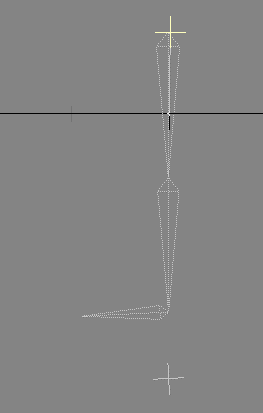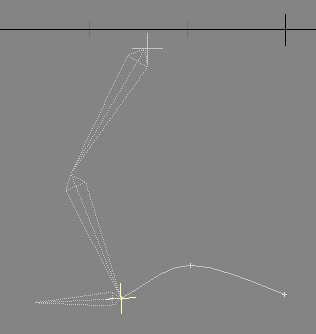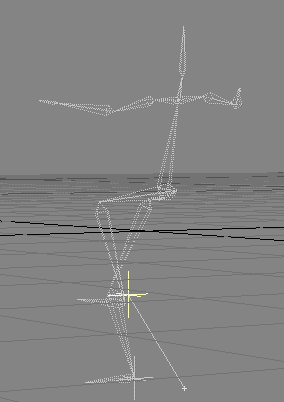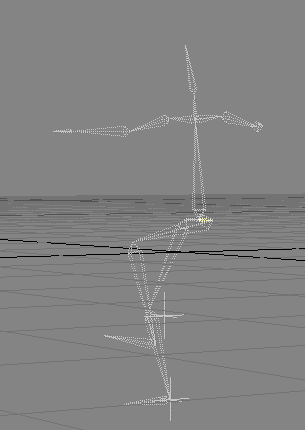3D Animation Workshop: Lesson 58: Using Inverse Kinematics | 2
|
|
Lesson 58 - Using Inverse Kinematics - Part 3
One half of IK is moving the goal to send IK up the chain. But it's equally important for holding down the end of the chain when we move elements further up. In our artificial model, we'll translate the null object that we had to create to parent our bones system. In a real boned character model, we'd use the root bone (at the pelvis). Watch what happens when we translate the parent object down.

The guy squats! Just think how difficult this would be to achieve using forward kinematics, because you have to work from the top of the chain down. The whole process would be counterintuitive.
If we translate the parent object up, the legs stretch out to their full extent. We have the freedom to pull the object away from the goal, and the legs will continue to reach for it. And why not. It's their "goal."

But jumping and squatting, however valuable, are still not the most important use of this aspect of inverse kinematics. Our natural walking step starts the pushing forward off our back heel to thrust our hips forward. This stretching out of the back leg, while pushing the hips forward, is effortless to achieve with IK.

When the hips have moved forward to the point where we lose our balance, the back foot is moved forward to break our fall. This is achieved with our system by grabbing the goal object to translate the foot in an arched path.

So the walking motion is achieved in IK through play between the top of the chain and the goal at the bottom of the chain. The top of the chain is translated forward to move the hips and upper body while stretching out the rear leg. The second half of the action is planting this leg in front of the body, such that the rear leg is now the back one. Walking is really a kind of controlled or cushioned falling in which the leg that pushes us off also breaks the fall. The other leg stays in place during the step, becoming the back leg for the following step. There's a lot of details to tweak, to be sure, but this is the basic idea. Test it out with your own body to get the feeling.
We'll get into the walking motion in more detail next time. But let's finish up our look at the basic principles of inverse kinematics with an important detail. Our little bones system includes only a single leg, which is necessarily only a single IK chain. Here is the complete bones system from the previous lesson with IK goals applied to both of the feet.

Watch what happens when we translate one of the goals up.

The upper body rotates. The IK process ramified up the chain from the foot all the way to the root bone at the center of the pelvis. When the root bone rotated, it rotated the entire upper body with it because the root bone is the parent of the entire skeleton. Make sure you understand this.
Different applications have different approaches to breaking a skeleton into independent IK chains. In Lightwave, we do it by choosing the first bone up the chain that we don't want to have affected. In this case it's the hip bone. With IK turned off at the hip bone, the translating the goal will rotate only the thigh and calf bones. Like so.

We'll delve further into this exciting subject next time.
| To Return to Parts 1 and 2, Use Arrow Buttons |
|
Created: Jan. 19, 1999
Revised: Jan. 19, 1999
URL: https://webreference.com/3d/lesson58/part3.html


 Find a programming school near you
Find a programming school near you